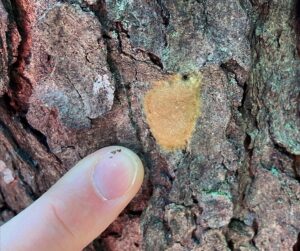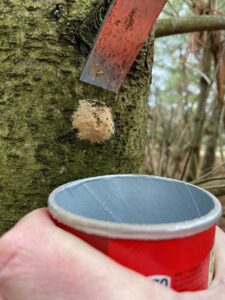
A closeup of a fresh spongy moth egg mass on a tree. Now is the time to locate and destroy egg masses to reduce the number of caterpillars attacking your trees in the spring. / Photo Credit: Bill McNee, Wisconsin DNR
As fall begins, landowners all over Wisconsin – including those involved in the Wisconsin Department of Natural Resources (DNR) Managed Forest Law program – are urged to remember the fight against spongy moths.
After all, the best time to put a dent in next year’s infestation is to spend some time during fall and winter finding and removing spongy moth egg masses – each of which contains 500 or more potential future caterpillars.
The invasive pest caused a state-record defoliation total of 373,000 acres in 2023. The outbreak seemed on track to continue in several areas of the state in 2024 until rain and cooler weather boosted the emergence of two natural enemies of spongy moth caterpillars, a virus and a fungus, which helped to greatly reduce the population in many areas last July.
Still, caterpillars survived to pupate, mate and leave behind egg masses that will become next spring’s batch of caterpillars. Fortunately for landowners, the next few months mark the best opportunity to attack the spongy moth population, eliminating the caterpillars before they have a chance to emerge and feed.
Egg masses will remain in their current locations until caterpillars begin to appear in mid-to-late April, leaving landowners with plenty of time to seek them out and destroy them. If the numbers suggest heavy defoliation in the spring, landowners can make advance plans for professional treatment once the caterpillars are out.

A metal or plastic knife or similar implement can be used to carefully scrape spongy moth egg masses into a cup of soapy water. Leave the egg mass in the water for two days to destroy the eggs inside. Photo Credit: Wisconsin DNR
Surveying for egg mass numbers on a specific property is the best way to predict if there will be a potential problem in the spring. The DNR offers an instructional video showing how to conduct a survey of egg masses over a few small portions of a property that will help the owner predict upcoming damage levels and plan for treatment. The University of Wisconsin-Madison Extension offers similar instructions in print form.
Some egg masses will be located too high up the tree to treat without special equipment. But on an infested tree, it’s likely that many egg masses can be removed by using a plastic knife or other implement to scrape them into a cup of soapy water. The DNR offers an instructional video on scraping egg masses.
For more information on spongy moth, visit the state’s interagency spongy moth resource center.
